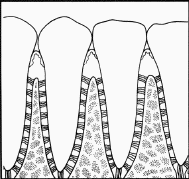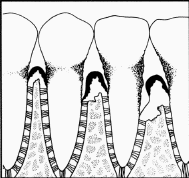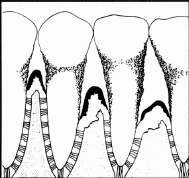Gum Disease
Periodontal disease, more commonly known as gum disease, is an infection of the gums, which support the teeth. This is the most common cause of tooth loss in adult patients. After 35, approximately three quarters of adults have experienced some form of this condition.
In many cases, this disease is the result of plaque, which is the sticky film that builds up on teeth when they aren’t maintained. The bacteria in this film release toxins that irritate the gums. Gum disease is known as gingivitis in its early stages and is characterized by red, swollen gums that bleed easily. This condition is reversible and can be resolved with regular brushing and flossing.
Many people fail to realize they have gum disease because it isn’t painful. However, during its advanced stages, the gums and the bone responsible for supporting teeth can become irreversibly damaged. This can cause loose teeth and tooth loss.
The Signs of Gum Disease
You should see your dentist right away if you noticed
— Bleeding during brushing
— Red, swollen or tender gums
— Gums that pull back from the teeth
— Chronic bad breath
— Puss around your teeth and gums
— Changes to your bite
— Partials that no longer fit
Normal, healthy gums and support bones will hold your teeth firmly in place.
Signs of Periodontitis
If plaque is not removed, it often hardens into tartar. As this continues to build up, the gums may begin to pull away from the teeth forming pockets between the teeth and gums.
Signs of Advanced Periodontitis
As the disease progresses, the gums recede even further, which destroys more bone and the periodontal ligament. Teeth may then become loose, requiring extraction.

Normal, healthy gums
Healthy gums and bone anchor teeth firmly in place.

Periodontitis
If not removed, plaque hardens into calculus
(tartar). As plaque and calculus continue to build up, the gums begin to recede (pull away) from the teeth, and pockets form between the teeth and gums.

Advanced periodontitis
The gums recede farther, destroying more bone and the periodontal ligament. Teeth — even healthy teeth — may become loose and need to be extracted.
How to Prevent Gum Disease
Fortunately, gum disease is completely preventable with regular home care and dental checkups. Following are the best ways to keep your teeth and gums as healthy as possible:
— Brush Your Teeth Twice a Day
Brushing removes the film of bacteria that builds on the teeth. Use a soft-bristled brush in good condition, along with toothpaste and mouth rinses that contain fluoride that strengthens the teeth and prevents decay. Look for the American Dental Association Seal of Acceptance. The ADA evaluates all advertising claims for products with this seal, giving you assurance against untrue statements. This means you are buying a quality product that will help you care for your teeth.
— Clean in Between Your Teeth
Flossing is one task many people ignore, but it’s necessary to ensure removal of bacteria and food particles that become trapped between your teeth. Interdental cleaners are an alternative, but it’s important to talk to your dentist to make sure you use them properly to avoid injuring your gums.
— Eat Well
Eat a balanced diet with foods from the four food groups including grain products, fruits and vegetables, dairy products and mean, poultry and fish. Reduce the number of snacks you enjoy between meals.
— See Your Dentist Often
Twice yearly dental checkups and cleanings are necessary to prevent the development of periodontal disease.
How to Treat Gum Disease
Early detection of gum disease is critical because this allows your dentist to easily treat it. There are several treatment options available. When combined with regular gum maintenance every three to four months, you can restore good oral health. Your treatment may include:
— A thorough exam of your gums and soft tissues
— Disease and prevention education
— Instructions for oral hygiene
— Scaling or root planing, often done with anesthesia –
We may recommend a deep cleaning to decrease bacteria and toxin by-products in the pockets created by gum disease to prevent further bone loss.
— Evaluation for further gum treatments
— Pocket reduction –
If the pockets are still too large after the scaling and planing, you may require surgery to decrease the pockets and keep your gums health.
— Antibiotic treatment –
In some cases, a non-surgical approach can manage early or moderate gum disease. After scaling and planing, specialized antibiotics will be administered.
— Grafting –
When bone loss is present, soft tissue and gone grafts can resolve the issue.
— Home maintenance –
Cleaning between your teeth using interdental cleaners or floss will help remove particles where the toothbrush can’t reach.
— Prescribed fluoride toothpaste –
A specialized toothbrush will remove plaque and keep your mouth in better condition.
— Regular dental visits –
When you have gum disease, you should see your dentist every two to four months as prescribed for a professional cleaning.